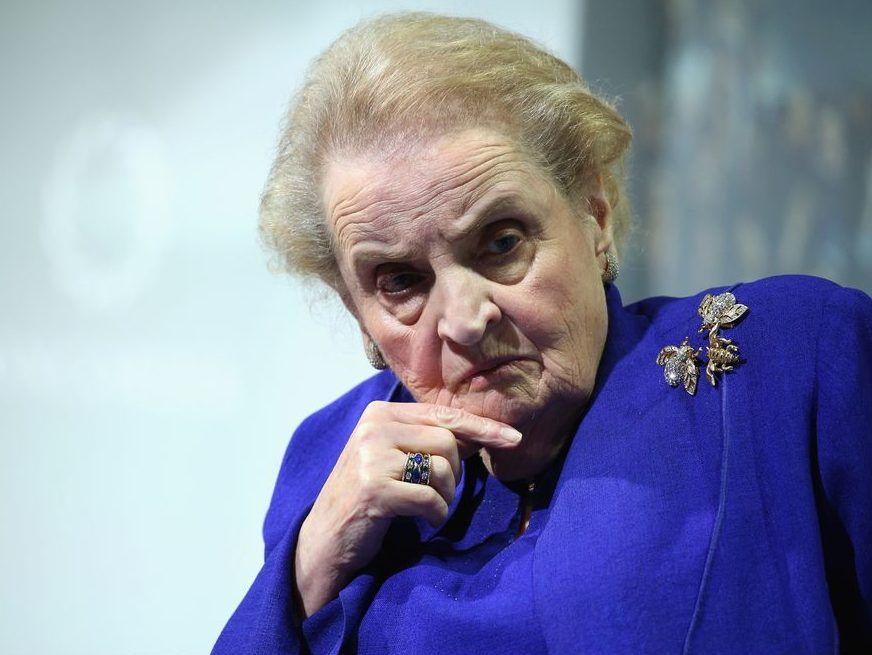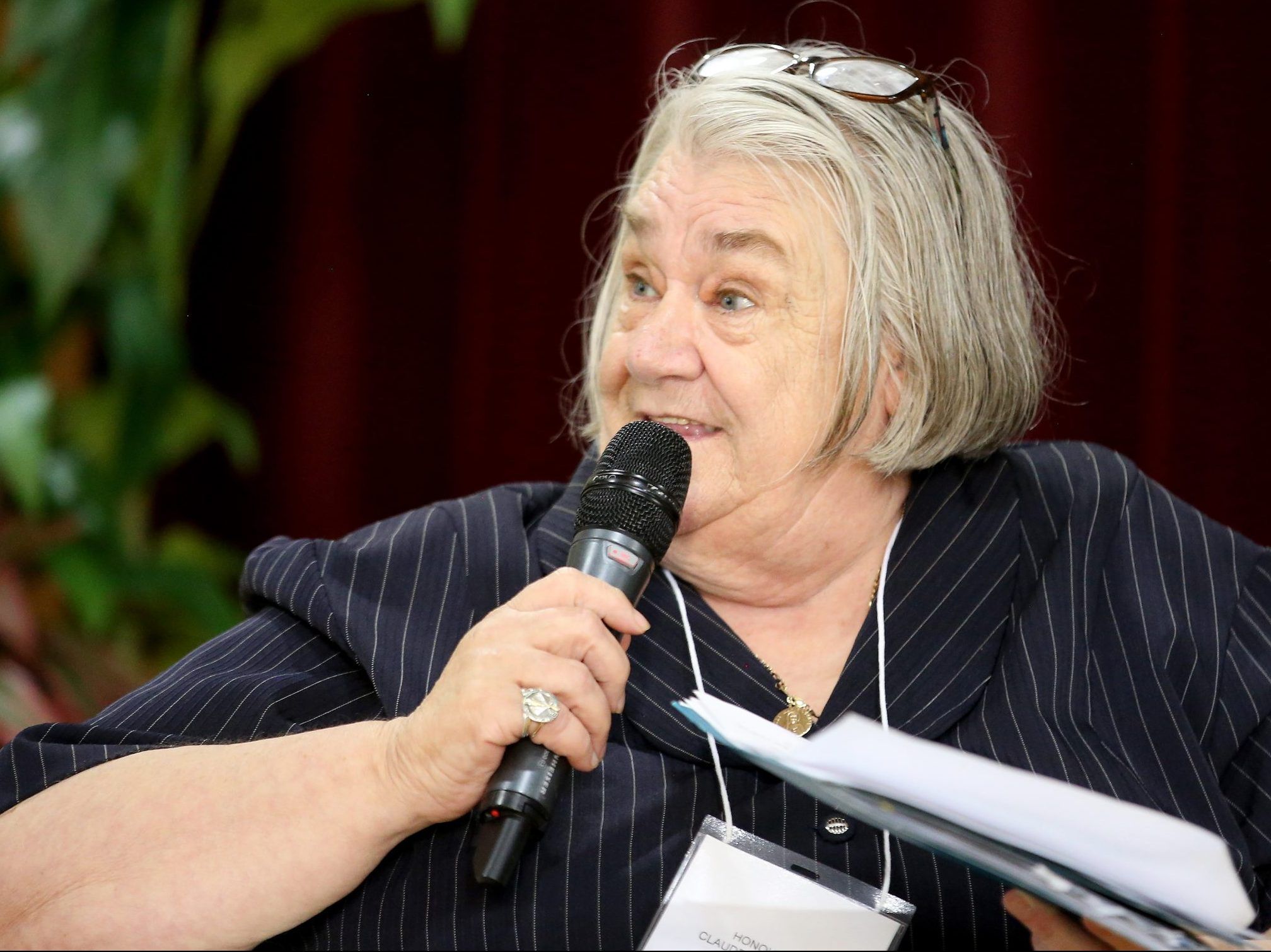Madeleine Albright, former U.S. secretary of state, dies at 84
Author of the article:Reuters
Reuters
Diane Bartz
Publishing date:Mar 23, 2022 • 15 hours ago • 5 minute read • Join the conversation
Chair, Albright Stonebridge Group; Chairman of the Board, National Democratic Institute Hon. Madeleine Albright speaks at the 2016 Concordia Summit - Day 2 at Grand Hyatt New York on September 20, 2016 in New York City.
Chair, Albright Stonebridge Group; Chairman of the Board, National Democratic Institute Hon. Madeleine Albright speaks at the 2016 Concordia Summit - Day 2 at Grand Hyatt New York on September 20, 2016 in New York City. PHOTO BY PAUL MORIGI /Getty Images for Concordia Summi
Article content
WASHINGTON — Madeleine Albright, who fled the Nazis as a child in her native Czechoslovakia during World War Two but rose to become the first female U.S. secretary of state and, in her later years, a pop culture feminist icon, died on Wednesday at the age of 84, her family said.
Advertisement 2
STORY CONTINUES BELOW
Article content
Albright was a tough-talking diplomat in an administration that hesitated to involve itself in the two biggest foreign policy crises of the 1990s – the genocides in Rwanda and Bosnia-Herzegovina.
“We are heartbroken to announce that Dr. Madeleine K. Albright, the 64th U.S. Secretary of State and the first woman to hold that position, passed away earlier today. The cause was cancer,” the family said on Twitter.
Albright was U.S. ambassador to the United Nations from 1993 to 1997 and U.S. President Bill Clinton’s secretary of state from 1997 to 2001.
While at the United Nations, she pressed for a tougher line against the Serbs in Bosnia after Bosnian Serb military forces laid siege to the capital Sarajevo.
During Clinton’s first term, many of the administration’s top foreign policy experts did not want to get involved because they vividly remembered how the United States became bogged down in Vietnam.
Advertisement 3
STORY CONTINUES BELOW
Article content
In 1995, Bosnian Serb soldiers overran three Moslem enclaves, Srebrenica, Gorazde and Zepa, and massacred more than 8,000 people.
The United States responded by working with NATO on airstrikes that forced an end to the war but only after it had been going on for three years.
Albright’s experience as a refugee prompted her to push for the United States to be a superpower which used that clout. She wanted a “muscular internationalism,” said James O’Brien, a senior adviser to Albright during the Bosnian war.
She once upset a Pentagon chief by asking why the military maintained more than 1 million men and women under arms if they never used them.
Early in the Clinton administration, while she unsuccessfully advocated for a quicker, stronger response in Bosnia, Albright backed a United Nations war crimes tribunal that eventually put the architects of that war, including Serbian President Slobodan Milosevic and Bosnian Serb leaders, in jail, O’Brien said.
Advertisement 4
STORY CONTINUES BELOW
Article content
The plain-spoken Albright took a tough line on a 1996 incident where Cuban jet fighters downed two unarmed U.S.-based planes, saying: “This is not cojones, this is cowardice,” using a Spanish vulgarity meaning “testicles.”
Albright, who was born in the former Czechoslovakia in 1937, was nominated to become the first woman secretary of state, and confirmed unanimously in 1997. She was in the post until 2001.
The painful lessons learned in Rwanda and Bosnia served the United States well in Kosovo, when Washington saw the more powerful Serbs begin a program of ethnic cleansing of ethnic Albanians. NATO responded with an 11-week campaign of air strikes in 1999 that extended to Belgrade.
During efforts to press North Korea to end its nuclear weapons program, which were eventually unsuccessful, Albright travelled to Pyongyang in 2000 to meet North Korean leader Kim Jong-il, becoming the highest ranking U.S. official to visit the secretive Communist-run country.
Advertisement 5
STORY CONTINUES BELOW
Article content
Once the Clinton years and the 1990s were over, Albright became an icon to a generation of young women looking for inspiration in their quest for opportunity and respect in the workplace. Albright was fond of saying: “There’s a special place in hell for women who don’t help each other.”
READ MY PINS
Albright was a marked contrast to her predecessors and male colleagues in uniform suits. She used clothes and jewelry to send tart, political messages. One favourite was a snake brooch, a reference to Iraqi leader Saddam Hussein calling her an “unparalleled serpent.”
She wrote a book about her signature jewelry, one of several bestsellers, explaining that the pins were a diplomatic tool. Balloons or flower pins would indicate she felt optimistic, while a crab or turtle would indicate frustration.
Advertisement 6
STORY CONTINUES BELOW
Article content
Born Marie Jana Korbelova in Prague on May 15, 1937, her family fled in 1939 to London when Germany occupied Czechoslovakia. She attended school in Switzerland at age 10 and adopted the name Madeleine.
She was raised a Roman Catholic but after she became secretary of state, the Washington Post dug up documentation showing that her family was Jewish and relatives, including three grandparents, died in the Holocaust. Her parents likely converted to Catholicism from Judaism to avoid persecution as Nazism gained strength in Europe, the paper reported.
After the war, the family left London and returned to Czechoslovakia, then in the throes of a communist takeover.
Her father, a diplomat and academic who opposed communism, moved the family to the United States where he taught international studies at the University of Denver. One of his favourite students was Condoleezza Rice, who would become the second female secretary of state in 2005 under Republican President George W. Bush.
Advertisement 7
STORY CONTINUES BELOW
Article content
“It is quite remarkable that this Czech émigré professor has trained two secretaries of state,” Albright told the New York Times in 2006.
Albright attended Wellesley College in Massachusetts, and got a doctorate from Columbia University. She became fluent or close to it in six languages including Czech, French, Polish and Russian as well as English.
In 1959, she married newspaper heir Joseph Medill Patterson Albright, whom she met while working at the Denver Post, and they had three daughters. They divorced in 1982.
She followed her father into academia but also became involved in Democratic politics. Albright joined the staff of Senator Edmund Muskie, a Maine Democrat, in 1976 and two years later became a member of President Jimmy Carter’s National Security Council staff.
Advertisement 8
STORY CONTINUES BELOW
Article content
Since leaving the Clinton administration, she has written a series of books. One, “Hell and Other Destinations,” was published in April 2020. Others include her autobiography, “Madam Secretary: A Memoir” (2003) and “Read My Pins: Stories from a Diplomat’s Jewel Box” (2009).
The plain-spoken Albright made forays into popular culture. “Parks and Recreation” star Amy Poehler’s character had a picture of Albright in her office.
In 2005, the “Gilmore Girls” television series the character Rory dreamt that Albright, wearing a red suit and an eagle pin, was her mother.
In 2018, she and fellow former secretaries of state Colin Powell and Hillary Clinton briefed a fictional secretary of state in “Madam Secretary,” where she spoke passionately about the dangers of abusive nationalism.
WASHINGTON — Madeleine Albright, who fled the Nazis as a child in her native Czechoslovakia during World War Two but rose to become the first female U.S. secretary …

torontosun.com
 ostmedia News
ostmedia News

 torontosun.com
torontosun.com



















